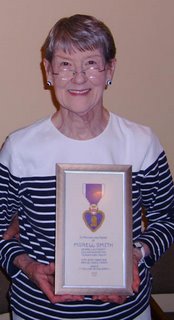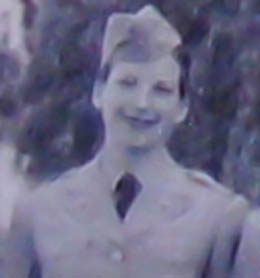Barbara Weston

By Peter Ciferri
A few months ago, when Barbara Weston called Newtown historian Mike Donovan, she was just catching up with an old friend.
Weston grew up in Newtown, living on the corner of Chancellor Street and Washington Avenue for nine years in the 30s. She spent 65 years living in Lower Bucks County before moving to Collegeville.
But when the conversation drifted to the topic of Morrell Smith, the only Newtown resident killed in action during World War I, and the man for whom American Legion Post #440 is named, Weston started thinking.
A few days earlier, she had found a needlepoint design featuring a Purple Heart medal and thought it might be a nice tribute to Smith. Now, that completed piece of art hangs proudly inside the walls of legion post 440.
“It means something extra because guys get Purple Hearts for minor wounds as well as major wounds, but it’s a very meaningful distinction,” Weston explained.
October 18, 2008 marks the 90th anniversary of Smith’s death on the battlefields of France.
A needlepoint aficionado, Weston said a typical stitching takes her just a few hours to complete and encourages others to support troops or veterans with similar tributes.
“I enjoy it. I enjoy doing it as much as I do completing it,” she said.
Weston herself is also a veteran. After receiving her nursing education from the Pennsylvania Hospital in Philadelphia, she joined the Army as a nurse in 1950.
Originally stationed in Beaumont, Texas, Weston spent much of her first months in the Army treating the wounded returning home from the Korean War. She says while many were returning seriously wounded, just as many were coming back seeking medicine and treatment for frostbite after that first bitter-cold winter in Korea.
“They weren’t expecting the conflict to last too long, so the soldiers didn’t even come prepared with winter boots,” Weston explained. She said the men came home to rest and the nurses were the front line for aid. “All they wanted was milk and sandwiches and a girl to talk to.”
For the girl who enlisted “because I wanted to see Texas” the reality of war was harsh.
“I will never forget that,” she said. “They just kept coming and coming.”
 After Texas, Weston was sent to Munich, Germany to aid in US hospitals operating during the reconstruction of a war-torn German landscape.
After Texas, Weston was sent to Munich, Germany to aid in US hospitals operating during the reconstruction of a war-torn German landscape.
“I have pictures, but they aren’t very pretty,” Weston explained. “There was still a lot of rubble.”
One picture was of her old nurses quarters — a makeshift home organized inside a house seized by the government. Years later, when her son returned to Munich on a business trip, he took a photo of the very same building: now rebuilt and in color.
“It was like in The Wizard of Oz, when Dorothy opens the door. It’s black and white before and then she goes into Oz and it’s in color,” Weston remembered.
Postwar Germany lay in ruins, and Munich was at the southern end of the U.S. command area. “We got sick and injured from all over the place,” she said.
While the war was over, polio and hepatitis were still rampant in the unclean German drinking water. Additionally, American soldiers and their families stationed overseas were under Weston’s control, and with the baby boom just taking flight, the delivery room was full.
Weston said she saw the boom start in Germany, and by the time she was back in America, it was common to see 200-250 babies born in each hospital each month.
“Nothing is scheduled ... so you could be terribly busy one shift and not so busy the next,” she recalled.Today, Weston is a member of the BuxMont Women’s Veterans Group, a collection of about 50 area servicewomen from all generations who meet regularly in Ardsley, Montgomery County.
While most of the women are from World War II or Korea, Weston said she is always happy to see new members join the group and encourages younger women to give it a try.
“We don’t make any distinction, we’re glad to have you,” she said. “We’re not going to be around that long, and it’s just important that people know.”
 RSS Feeds
RSS Feeds




0 Comments:
Post a Comment
<< Home